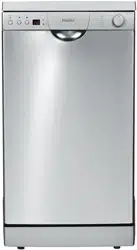
Dishwasher
TFE3 Series
Instructions for Use
HDW9-TFE3WH
HDW9-TFE3SS
0120505889A
en
POWER3 in 1 DELAY
HEAVY
NORMAL
LIGHT
GLASSWARE
PRE-RINSE
RINSE
QUICK 30
1
2
3
4
5
6
7
Loading ...
Loading ...
Loading ...

For HDW9TFE3SS2. Series: TFE3 Series
Also, The document are for others Haier models: HDW9-TFE3WH, HDW9-TFE3SS

Haier in United States
1-877-337-3639 Monday-Friday: 8am-8pm ET Saturday: 8am-7pm ET